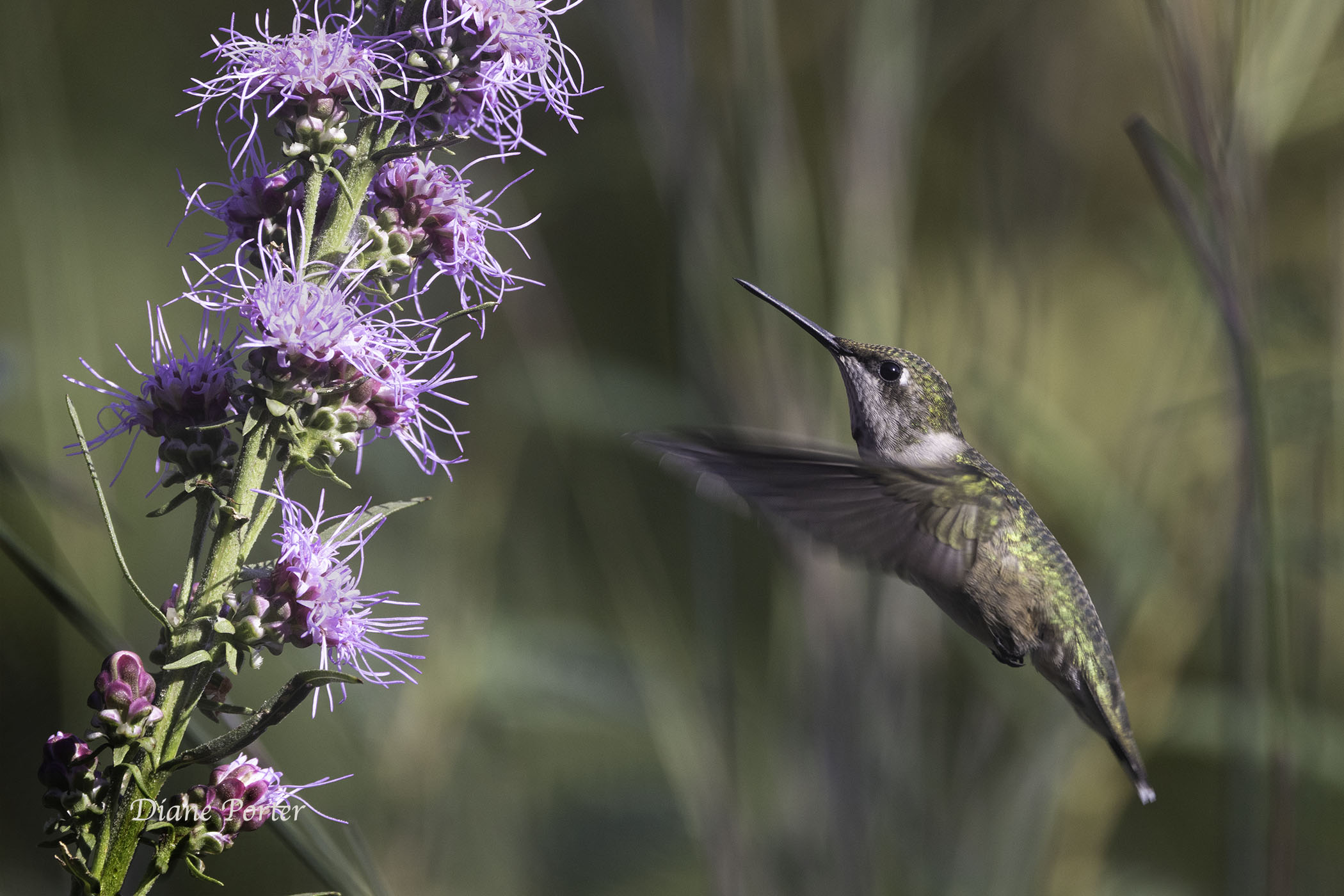Diane Porter of Fairfield first published this post on My Gaia, an email newsletter “about getting to know nature” and “giving her a helping hand in our own backyards.” Diane also maintains the Birdwatching Dot Com website and bird blog.
On September 9 I watched a Ruby-throated Hummingbird visit the purple blossoms of Rough Blazing Star (Liatris aspera). For a couple of seconds she hovers at bill’s length from the flowers, then moves slightly up or around the stalk. I couldn’t see her tongue, but I knew she was using it to slurp out the nectar.
Most adult males had already migrated out of Iowa by that time. Females and the young of the year linger a while longer. They zip around seeking flower sugar, which they will put away in the form of hummingbird fat. They must store calories to power their long migratory flight south, right across the Gulf of Mexico and on into Central America.

Rough Blazing Star with its 2-foot-long spike of flowers
In bloom, Rough Blazing Star is a pole of purple. Its flowers are clustered into what look like tufted buttons along its length. A “button” could be mistaken for an individual flower, but it’s really a little bouquet, a composite of dozens of tiny flowers — florets — bound together at their bases.

Each Rough Blazing Star “button” has about 30 to 80 florets
Each floret will develop a seed. But first it must get pollinated. It offers a tiny gift of nectar to potential pollinators. Bees and butterflies are always working the flowers. A bumblebee laps up nectar with its long, hairy tongue.

A butterfly unfurls its proboscis, probes the flower, and sucks up sweetness. In the process, the flower is pollinated.

Peck’s Skipper finding nectar in Rough Blazing Star florets
In late summer, when many of hummers’ mainstay flowers are past (such as Cardinal Flower and Wild Bergamot), hummingbirds also attend Rough Blazing Star. A hovering hummingbird reaches into the bottom of each flower with her tongue, which she can stick out twice the length of her bill.

Migrating Ruby-throated Hummingbird feeding at Rough Blazing Star
It’s hard to see it, because the tongue as thin as a human hair. It moves accurately and faster than our eyes can follow. She flicks it into hundreds of tiny florets, winning a microscopic bit of nectar with each thrust.
The florets open over several days, starting with the outermost ones. Central floret remain longer with their five petals closed.

I try to imagine what the small bird sees, with her close view of the miniature blossoms. Just like many garden flowers, each floret has five out-flaring petals. They join in a tube, at the bottom of which the nectar pools.
Here’s a microscopic view of a single floret of Rough Blazing Star. It has five petals and a long, double style to capture grains of pollen.

From each floret, a long purple thread emerges. As it lengthens, it splits in two and waves in the air as if searching. Searching for pollen. The double thread is the style, the floret’s female structure. The tips are sticky, and they hold onto any pollen that touches them. The pollen comes to them on the bodies of the insects and hummingbirds who feed at the blossoms.
Blooming late in the flowering season, Rough Blazing Star is ready right when hummingbirds are migrating through the Midwest and their energy need is great.
This plant’s scientific name is Liatris aspera. The second word means rough. It refers to the fuzzy look that the waving styles create.

They also bring their sweetness to my garden at the time when many flowers have stopped blooming.


3 Comments
Lovely post about a lovely flower, thank you!
I know of two little prairie remnants in my county that used to have blooming rough blazingstars. Those remnants were destroyed over the past three decades by trees and shrubs. In one case, the trees and shrubs invaded the prairie, as they usually do in today’s Iowa, and they successfully extinguished the remnant because there was no effort by the landowner to stop them. (I heard about that one and was shown the location by a sad local botanist).
In the other case, rows of trees were deliberately planted on top of the prairie remnant at taxpayer expense because the USDA had a program that didn’t care where trees were planted as long as trees were planted. In those days, the USDA seemed to be prairie-illiterate. Unfortunately, many other prairie remnants in Iowa and other Upper Midwest states were also destroyed by USDA-funded tree and shrub plantings. I hope to heaven that isn’t happening any more.
PrairieFan Thu 18 Sep 10:41 PM
No title
How sad. I didn’t know about that program.
Laura Belin Sat 20 Sep 8:25 AM
Unfortunately, there were two main ways that USDA conservation programs destroyed Upper Midwest prairie remnants.
The first was the tree-planting program described above. The second was the early version of the Conservation Reserve Program, which caused original-prairie pastures to be obliterated via bulldozers and tillage and then planted to soybeans for a couple of years so they would qualify for CRP enrollment. And then, ironically, they were sometimes planted with inferior new versions of the prairie remnants that had been destroyed.
The USDA has now become more enlightened about prairies, fortunately. But various public policy problems remain. For example, last I heard, the Iowa DOT is legally required to consider the existence of native woodlands and wetlands when planning routes for the construction of new roads. But unless there has been a change in the Iowa Code, prairie remnants don’t get the same consideration.
PrairieFan Sun 21 Sep 8:47 PM